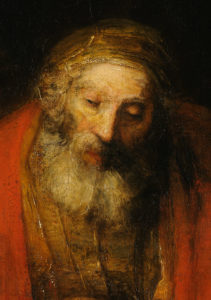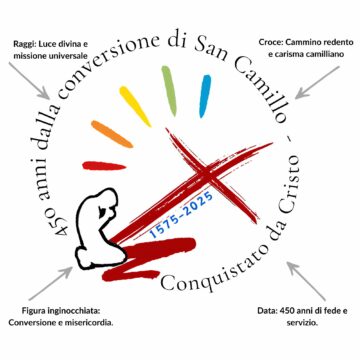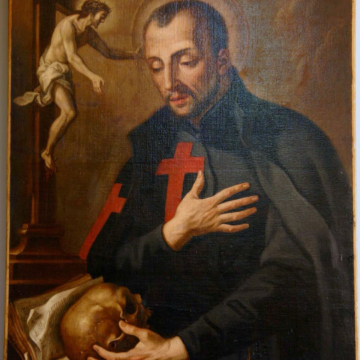Is it reasonable to produce an essay to outline analogies between ‘The Return of the Prodigal Son’ by Rembrandt and the practice of medicine? At the outset, we could argue that this Dutch painter was inspired by the three parables on mercy and forgiveness taught by Jesus but narrated only in the Gospel of Luke. In the gospel texts attributed to the other Evangelists, Matthew, Mark and John, no mention is made of this passage from the life of Christ. We may observe that Luke was a physician and was involved in proclaiming the activity of mercy and forgiveness of Jesus, especially for pagans – people who up to that moment had been excluded from the project of salvation. It appears that we have a good justification for addressing this challenge.
The ‘Return of the Prodigal Son’ is probably one of the last paintings by the Dutch master of the seventeenth century and it is exhibited at the Hermitage Museum of St. Petersburg in Russia. When purchasing an entrance ticket to a museum that is considered one of the most important in the world, the visitor already understands the importance of this masterpiece because the ticket has a picture of the work in question. More than any other painter, Rembrandt saw his pictorial art as guided by a wish to involve the observer in an environment of great emotion. In establishing as a priority in the mission of Christ the welcoming of the most vulnerable, Luke the Evangelist made use of his knowledge as a physician who was used to being with people who were weakened by the illnesses of that epoch. This is the reason why the honour of being the patron saint of medicine was bestowed upon him.
The parable of the prodigal son and the two parables that precede it in the Gospel of Luke, the parable of the lost sheep and the parable of the lost drachma, constitute a special context by which to reveal the magnanimity of the love of God, His unconditional welcoming of sinners who seek forgiveness, and care for spiritual health, a pathway that is similar to that of patients who seek to cure their physical illnesses through medical treatment.
The text of Luke (15:11-32) employs three iconic characters: the father, the younger son (the ‘prodigal son’), and the older son (who remained with his father on the family property). The younger son, who is repentant and returns to his father’s house after wasting all of his inheritance on a dissolute life, prostrates himself in front of his father and asks him for forgiveness and to be welcomed. His father, moved by pity, exults at the return of his son who was lost and accepts him with a warm and noble welcome. In the description given by the Evangelist, the older son was in the field at the moment of the meeting of his father with his brother who had returned. Luke says: ‘And as he came and drew near to the house, he heard music and dancing…But he was angry and refused to go in’.
Why was it that Rembrandt, in opposition to the holy text, painted the brothers together at that moment of great excitement? In beholding the masterpiece of the Dutch master, we can imagine the possible intentions of the painter. We will look, therefore, for the details that reveal the emotions that dominate each of the three human figures painted by the artist. First, however, we should emphasise the importance of the light around the characters painted by Rembrandt, a resource often used to guide the eye of the observer towards the prominent points of the greater drama projected onto the screen of the canvas.
Many experts, faced with the emotions provoked by looking at famous paintings, often use the phrase ‘this canvas speaks for itself’. The ‘Return of the Prodigal Son’ by Rembrandt, in my  view, is one of the greatest and richest examples of this perception of the great experts of the fine arts. Consider the following: the figure of the older brother, surrounded by the same rich gown that covers the back of his father, reveals his status of nobility or, to put it better, his personality which has shared in the wealth of his father and the comfort of his house, both of which experienced with the haughty dignity of the first born, the heir to his father’s fortune, showing that he is able to command and be obeyed by his subordinates.
view, is one of the greatest and richest examples of this perception of the great experts of the fine arts. Consider the following: the figure of the older brother, surrounded by the same rich gown that covers the back of his father, reveals his status of nobility or, to put it better, his personality which has shared in the wealth of his father and the comfort of his house, both of which experienced with the haughty dignity of the first born, the heir to his father’s fortune, showing that he is able to command and be obeyed by his subordinates.
He is standing far from his brother who has come back to the house of his father after revealing a complete inability to manage his own life. The light that surrounds him is limited to his head and reveals a look of superiority; his clasped hands show contempt for the person who is stretched out on the ground like a human rag at the feet of his father. The older brother demonstrates to everyone a total lack of mercy for the repentant sinner.
In the words of the Evangelist, the pride of the older brother was wounded by the incomprehensible attitude of the welcoming father. This meant that he refused to take part in the party to celebrate his dissolute brother, identifying him as ‘your son’, which demonstrated the whole of his hatred and dismay at not having received the same attention from his father, even though he had remained faithful and obedient to his father’s orders. The prodigal son who has returned is painted by Rembrandt as a marginalised man marked by physical and moral decay, with his head shaved like a slave, on his knees and powerless, his clothes in rags, without a cloak, with his sandals worn out and with his right foot soiled by dirt, demonstrating his profound moral suffering. His left foot with its bleeding wounds represents the pain caused by his lacerating journey of physical suffering. The only evidence that denotes his noble origins is the dagger on his waist (hidden by the clothes that surround his body), because at that time only nobles had the right to carry this dagger.
The figure of the father who embraces his son is central and emanates an intense light that extends from his head to the floor of the room, covering the figure of the prodigal son. The father is portrayed as a man at peace with himself, with a beard, with white hair and with his eyes closed. An aura of extreme tenderness surrounds him. One detail that attracts the attention of the observer is the anatomical asymmetry of the hands of the father. His right hand with its soft almost female features seems to support the moral suffering of the young man. His left hand is strong and supports all the weight of the suffering body of the prodigal son, leading us to presume that he is offering protection to the physical suffering of this person who has accumulated so much suffering during his unhappy journey. In short, everything indicates that the father represents the merciful figure described by Luke, the man who not only forgives but also reintegrates the prodigal son into his family, restoring to him all of his lost dignity.
 Now, to end these reflections, it would be possible to answer the question formulated at the beginning of this essay, that is to say, what are the possible analogies between the story painted in the masterpiece by Rembrandt and the practice of medicine? It seems natural to recognise the likeness of the prodigal son of the canvas by the Dutch master to a sick and anonymous person who, in a frail state, looks for medical treatment. Both as bio-psycho-social and as spiritual beings we constantly encounter threatened lives that require the care of a competent authority that is able to offer the desired return to full physical and emotional health. Is it too much to recognise that the suffering of the prodigal son of the Gospel of Luke greatly resembles the same suffering of innumerable humble patients, the users of the public health-care system of our country? To sum up, the prodigal son of Rembrandt visits the medical clinics and the medical doctors and lecturers of our schools of medicine.
Now, to end these reflections, it would be possible to answer the question formulated at the beginning of this essay, that is to say, what are the possible analogies between the story painted in the masterpiece by Rembrandt and the practice of medicine? It seems natural to recognise the likeness of the prodigal son of the canvas by the Dutch master to a sick and anonymous person who, in a frail state, looks for medical treatment. Both as bio-psycho-social and as spiritual beings we constantly encounter threatened lives that require the care of a competent authority that is able to offer the desired return to full physical and emotional health. Is it too much to recognise that the suffering of the prodigal son of the Gospel of Luke greatly resembles the same suffering of innumerable humble patients, the users of the public health-care system of our country? To sum up, the prodigal son of Rembrandt visits the medical clinics and the medical doctors and lecturers of our schools of medicine.
What likenesses can we perceive between the figure of the father and the figure of the first-born son portrayed in the painting, on the one hand, and the professionals who currently practice medicine in Brazil, on the other? Certainly some of them in their routine activity are able and manage to approach the welcoming attitude of the father, differently to what Gaillard proposes in his work O médico do futuro: para uma nova lógica médica in which the author describes the six stages that are needed to characterise a medical act: welcome followed by anamnesis, a physical examination, a diagnosis, the prescribing of treatment, and separation.
What is perceived in contemporary medical care is a completely different reality. This consists of providing care in the shortest time possible, prescribing any medical product to the patient, requesting some laboratory tests and in the end trying to terminate this bothersome and underpaid undertaking. In high-tech medicine, which has replaced high-touch medicine, there is no longer any room for a careful, welcoming and detailed physical examination. Many statements explain this abstruse professional behaviour but all of them are unable to justify it. These justifications include low salaries and insufficient investments in public health which undoubtedly broaden the gap between a medical doctor and his or her patient. But such attitudes also reveal, on the one hand, the base arrogance of knowledge and, on the other, the progressive adherence of professionals to a misguided defensive medicine. This situation makes eloquent the similarity of the medical doctor of our time to the figure of the older son in the painting by Rembrandt, with the same unbearable contempt for human suffering, towards both the younger son in the gospel passage of Luke and the humble patients scattered in all the corners of our unjust and unfair country.
It is essential, therefore, to intensify the search for new strategies that seek to train medical doctors who can increasingly remind us of the figure of the father in the masterpiece by Rembrandt; professionals who possess the skills to welcome and recognise the real dimension of human suffering; who know how to maintain a satisfactory and effective relationship; and who are ready to adopt shared clinical decisions that respect the personal values and beliefs of the patients they serve. There is no absence in the specialised literature of data that demonstrate in an unequivocal way the need for the professionals of medicine and health to be endowed with these new attitudes towards the practice of medicine so that they can honour the teachings of the father of medicine (‘Hippocrates’) who included amongst his rules the following command: ‘where there is love for the man [the patient], there will also be love for the art [medicine]’.
References
J.R. GAILLARD, O médico do futuro: para uma nova lógica médica (Instituto Piaget, Lisbon, 1995).
CENTRO INTERNACIONAL DE PESQUISAS E ESTUDOS TRANSDISCIPLINARES. Que universidade para o amanhã?: em busca de uma evolução transdisciplinar da universidade (Ciret-Unesco, Locarno, 1997).
FRENK et al., ‘Health professionals for a new century: transforming education to strengthen health systems in an independent world’, The Lancet, Oxford, 2010, v. 576, n. 9756, pp. 1923-1958.
F.H. Cairus and W. Ribeiro Junior, Textos hipocráticos: o doente, o médico e a doença (Fiocruz, Rio de Janeiro, 2005)
* José Eduardo de Siqueira is a specialist in cardiology; he has a master’s degree in bioethics from the National University of Chile; he became a doctor in clinical medicine at the State University of Londrina (UEL); he is a member of the technical committee for palliative care of the CFM; he is a member of the national committee of ethics in research (CONEP); and he is the author of numerous books on bioethics and medicine.











